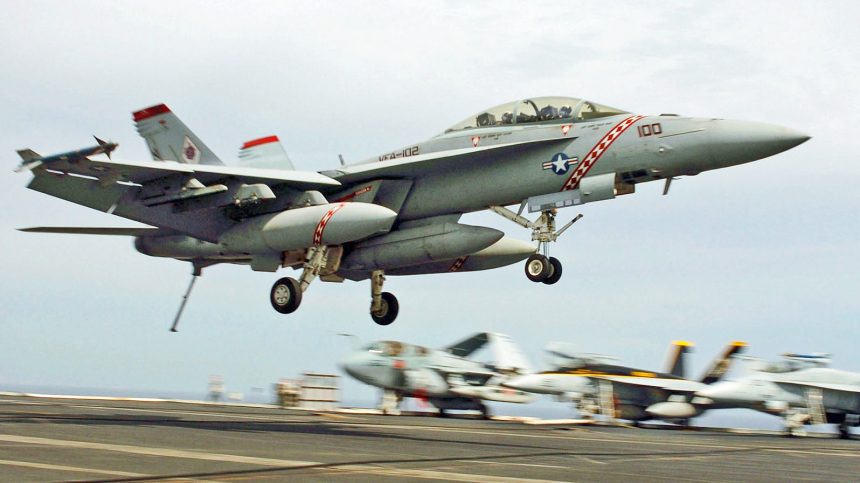It’s also the Second Crash for Reagan in One Month Following MH-60 Seahawk Crash Last Month.
A two-seat U.S. Navy F/A-18F Super Hornet has crashed at sea while operating from the aircraft carrier USS Ronald Reagan (CVN-76). The crash occurred at an unspecified location northeast of the Philippines on Monday, November 12, 2018. Reports indicate both crew members ejected and were rescued from the sea by helicopter.
The USS Ronald Reagan is currently embarked in the Pacific region with Carrier Air Wing Five (CVW-5). The Air Wing lists one unit as operating the two-seat F/A-18F Super Hornet variant, Strike Fighter Squadron 102 (VFA-102), the “Diamondbacks”.
According to the official U.S. Navy website, “CVW-5 is the air combat arm of Battle Force 7th Fleet, with warfighting assets that include the F/A-18E/F Super Hornet, EA-18G Growler, C-2A Greyhound, MH-60R and MH-60S [helicopters], as well as the latest addition of the E-2D Hawkeye.”
The Boeing F/A-18F Super Hornet is a successful, two-seat, twin-engine combat aircraft derived from the original F/A-18 Hornet first flown by McDonnell Douglas in 1978. The F/A-18F Super Hornet aircraft currently serves with the U.S. Navy and Australia’s military. The F/A-18F Super Hornet variant is an advanced variant of the original F/A-18 with a 25% larger airframe, larger wings, upgraded engines and two crewmen. It performs the attack role for the U.S. Navy.
This is the second accident for an aircraft from the USS Ronald Reagan in less than a month. On October 19, 2018, A U.S. Navy MH-60 helicopter attempted an emergency landing onboard the USS Ronald Reagan and crashed, injuring 12 crewmen. Three of the crewman remained hospitalized according to an October 25, 2018 report by Caitlin Doornbos published in Stars and Stripes.
In early October, journalist Kyle Mizokami of Popular Mechanics reported that the U.S. Navy had made changes to its Naval Safety Center Data Management web portal that previously published statistics for U.S. Navy aviation accidents. The crash statistics for U.S. Navy aircraft are no longer available for persons without military clearance. This change effectively hinders reporters from publishing statistics about cumulative aviation accidents within the U.S. Navy.
In his October 9, 2018 report for Popular Mechanics, Mizokami wrote, “The data is still there, but civilians, including reporters, are restricted from seeing it. The Navy has placed the data behind a digital wall where only Common Access Card (CAC) holders have access. CACs are only available to active-duty military, military reserves, government contractors, and civilian DOD employees.”
This is also the second deadly accident, involving a two-seater Super Hornet in 2018: on Mar. 14, 2018 an example of the Strike Fighter Attack Squadron (VFA) 213 “Black Lions” based at Naval Air Station Oceana, Virginia went down one mile east of the runway at Boca Chica Field, Naval Air Station Key West. Both crew members were killed in the crash.
Previously, a single-seat F/A-18E of Strike Fighter Squadron (VFA) 146 assigned to the USS Nimitz (CVN 68) departed the runway during an emergency landing at Bahrain International Airport on Aug. 12, 2017. The pilot successfully ejected. On Apr. 21, 2017, a VFA-137 F/A-18E crashed during a landing attempt on USS Carl Vinson (CVN 70) in the Celebes sea, between Indonesia and the Philippines. The previous year, two VFA-211 F/A-18F jets from NAS Oceana collided and crashed 25 miles E of the Oregon Inlet, Nags Head, NC on May 26, 2016; earlier this year, on
Legacy Hornets have also crashed at an alarming rate as we have already reported in the past: two U.S. Marine Corps F-18 Hornets from MCAS Miramar crashed on Nov. 9, 2016 near San Diego. Another F/A-18C crashed near USMC Air Ground Combat Cente, Twentynine Palms, on Oct. 25, 2016. A U.S. Navy F/A-18C belonging to the Strike Fighter Wing Pacific, Detachment Fallon, crashed on Aug. 2, 2016, 10NM to the south of NAS Fallon. On Jul. 27, 2016 a USMC F/A-18 belonging to the 3rd Marine Aircraft Wing crashed during a night strafing run on a weapons range near Twentynine Palms (killing the pilot). On Jun. 2 a Blue Angels Hornet crashed after taking off from Smyrna/Rutherford County Airport (KMQY), Smyrna, Tennessee: the only pilot on board was killed in the incident.
Foreign Hornet operators have also suffered losses.
In October 2017, a Spanish EF-18 Hornet, belonging to the Ala 12, crashed during take off from its homebase at Torrejon Air Base, near Madrid, killing the pilot. Then, in January this year, a Royal Australian Air Force EA-18G Growler, the electronic warfare variant of the Super Hornet, caught fire during take-off at Nellis AFB, Nevada while participating in the Red Flag 18-1 combat training exercise. Both crew members were uninjured in the incident.
Here’s what The Aviationist’s David Cenciotti wrote last year, commenting such crashes:
Aircraft may crash for a variety of reasons, not always technical ones. Still, the rate of Hornet crashes in the last years seems to be unusual and, as such, concerning.
According to a report published in September 2016 by Stars and Stripes, since 2012, the number of major Navy and Marine Hornet and Super Hornet accidents have increased by 44 percent as a consequence of sequestration and subsequent cuts in flight hours for training at home.
Moreover, F/A-18 Hornets of all variants have shown a steady yearly increases of what the Navy calls “physiological episodes” due to oxygen deprivation and cabin decompression since May 1, 2010, and the U.S. Navy has linked the deaths of four Hornet pilots that occurred over a span of 10 years to “physiological episodes” (PE). Such deadly incidents are not all the direct result an oxygen system failure but are linked by the fact that pilots experienced various symptoms that fall within the scope of a PE: dizziness, vertigo, oxygen shortage, blackouts, etc.
The Super Hornet incident on Nov. 12 is the second involving a U.S. Super Hornet in 2018, the sixth one since May 2016.









